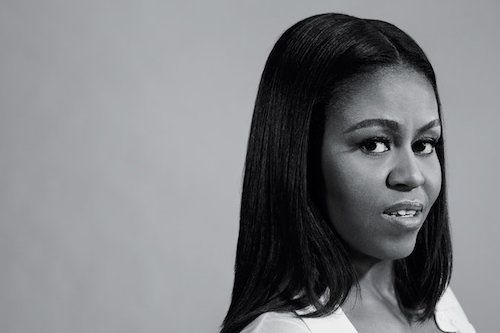
This New York Times Style Magazine shoot....a MOMENT! FLOTUS Michelle Obama gave us authentic, beautiful blackness for this shoot. And it's arguably her most stunning one yet. Get the pics inside that have everyone in a tizzy, plus the love letters written to her in the issue by fellow amazing women.
For The Greats issue of NYT's Style magazine, it's only right our First Lady -- wearing Roberto Coin earrings and a Calvin Klein Collection top, gets top billing. There are several other covers for the issue with other Greats, but this one is something special.
The chic, gorgeous, and strong Chicago-born beauty is flawlessly serving in a way that's taking folks' breath away. The love letters saluting her greatness accompanying the Collier Schorr-shoot are pretty much perfect. What she's meant to the progression of feminism, career-family balance, and black womanhood have not been overlooked.
Chimamanda Ngozi Adichie, author of the novel “Americanah” and book-length essay “We Should All Be Feminists,” wrote one of the four love letters comprising the story. Here's an excerpt:
She first appeared in the public consciousness, all common sense and mordant humor, at ease in her skin. She had the air of a woman who could balance a checkbook, and who knew a good deal when she saw it, and who would tell off whomever needed telling off. She was tall and sure and stylish. She was reluctant to be first lady, and did not hide her reluctance beneath platitudes. She seemed not so much unique as true. She sharpened her husband’s then-hazy form, made him solid, more than just a dream.
But she had to flatten herself to better fit the mold of first lady. At the law firm where they met before love felled them, she had been her husband’s mentor; they seemed to be truly friends, partners, equals in a modern marriage in a new American century. Yet voters and observers, wide strips of America, wanted her to conform and defer, to cleanse her tongue of wit and barb. When she spoke of his bad morning-breath, a quirky and humanizing detail, she was accused of emasculating him.
Because she said what she thought, and because she smiled only when she felt like smiling, and not constantly and vacuously, America’s cheapest caricature was cast on her: the Angry Black Woman. Women, in general, are not permitted anger — but from black American women, there is an added expectation of interminable gratitude, the closer to groveling the better, as though their citizenship is a phenomenon that they cannot take for granted.

Another excerpt describing Mrs. O's epic trajectory, now in 2016:
She had become an American style icon. Her dresses and workouts. Her carriage and curves. Toned arms and long slender fingers. Even her favored kitten heels, for women who cannot fathom wearing shoes in the halfway house between flats and high heels, have earned a certain respect because of her. No public figure better embodies that mantra of full female selfhood: Wear what you like.
It was the 2016 Democratic Convention. Michelle Obama was speaking. She said “black boy” and “slaves,” words she would not have said eight years ago because eight years ago any concrete gesturing to blackness would have had real consequences.
She was relaxed, emotional, sentimental. Her uncertainties laid to rest. Her rhythm was subtler, because she no longer needed it as her armor, because she had conquered.
The insults, those barefaced and those adorned as jokes, the acidic scrutiny, the manufactured scandals, the base questioning of legitimacy, the tone of disrespect, so ubiquitous, so casual. She had faced them and sometimes she hurt and sometimes she blinked but throughout she remained herself.
Michelle Obama was speaking. I realized then that she hadn’t been waiting to exhale these past eight years. She had been letting that breath out, in small movements, careful because she had to be, but exhaling still.
Just, everything.


Actress Rashida Jones wrote one of the love letters as well, and she summed up things perfectly:
If feminism’s goal is equal opportunity and choice, Michelle makes me feel like every choice is available. You can go to Princeton and Harvard, you can rap with Missy Elliott, you can be a mother and a lawyer and a powerful orator. You can champion the Lilly Ledbetter Fair Pay Act, while also caring about fashion. You can dance with Ellen and also fearlessly remind people, on live television, of the reality of your position: “I wake up every morning in a house that was built by slaves. And I watch my daughters, two beautiful, intelligent, black young women, playing with their dogs on the White House lawn.” You can be your husband’s partner and supporter, and also use your cultural and political capital to campaign for Hillary Clinton, unflinchingly standing up to her “locker room talk”-ing bully of an opponent with the battle cry “enough is enough!” — eloquently putting into words what a lot of people, myself included, had been feeling.
Michelle Obama will have her own legacy, separate from her husband’s. And it will be that she was the first first lady to show women that they don’t have to choose. That it’s okay to be everything.
You can read the love letters in full, plus two more from iconic feminnist Gloria Steinem and Pulitzer Prize-winning biographer John Meachem (who wrote President George Bush's life story) HERE.
Photos: NYTimes


















